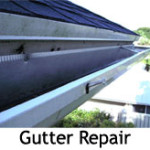Gutter Glossary
Gutter Glossary
Below is our gutter glossary, a list of common industry terms associated with Rain Gutters. If you have a question regarding a specific term or for one not listed, please call All Gutter Systems and we’ll be happy to offer a definition.
Apron Flashing: A horizontal flashing installed where the top end of a roof slope meets a vertical projection, such as a chimney or parapet wall.
Barge: A finishing at the gable end of a roof, fixed parallel to the roof slope.
Box Gutter: A gutter not at an eave, typically at the base of two opposing roof slopes.
Bid: A formal offer by a contractor, in accordance with specifications for a project, to do all or a phase of the work at a certain price in accordance with the terms and conditions stated in the offer.
Box Miter: Adjoins to pieces of gutter at a 90 degree angle inside or outside
Brick mold: Trim used around an exterior door-jamb that siding butts to.
Built-up roof: A roofing composed of three to five layers of asphalt felt laminated with coal tar, pitch, or asphalt. The top is finished with crushed slag or gravel. Generally used on flat or low-pitched roofs.
Cap flashing: The portion of the flashing attached to a vertical surface to prevent water from migrating behind the base flashing.
Capping: A cover at the top of a gap that weatherproofs, typically at the ridge of a pitched roof.
Chimney Gutter: See Soaker.
CGI: See Corrugated Roofing.
Cladding: Sheeting that encloses a building-roofing and walling.
Counter (or Over) Flashing: A flashing dressed down as a cover only, over a separate upstand.
Downpipe: A pipe to carry roof water from gutters and roof catchments to drains or storage tanks.
Drainage: A system of gutters and drainpipes that carry water away from the foundation of a house.
Drip Edge: A non-corrosive, non-staining material used along the eaves and rakes to allow water run-off to drip clear of underlying construction.
Drop: See Pop.
Drop Outlet: Formed piece that serves as the hole from which the water travels from the horizontal section of the gutter to the downspout.
Eaves Gutter: A roof gutter attached at an eaves overhang.
Elbow: Pre-finished angled piece for directing water flow.
Electrolytic (galvanic) Corrosion: Corrosion resulting from the contact of two different metals when an electrolyte (like water) is present.
End Cap: Flat formed piece that is placed at the end of a gutter section.
Expansion Joint: A joint in a long run of cladding, gutter or flashing designed to allow for thermal expansion and contraction.
Fall (slope): The slope of the roof or gutter, often expressed in degrees, or as a ratio of vertical height to horizontal distance (e.g. 1 in 20).
Fascia (fascia board): A flat board that runs horizontally along the eaves of a roof, typically capping the ends of the roof rafters to give the roof edge a more finished look and provide a base for attaching gutters.
Fixings Screws: nails or clouts used to fasten cladding to a building structure.
Flashing: A material, usually metal, used to waterproof the junction between two intersecting roofs and/or wall surfaces. At a masonry wall, it is often built into the mortar.
Galvanized Steel: Steel sheeting protected against corrosion by a zinc coating applied by the continuous hot-dip process.
Girth: The width of the blank strip from which a profile is rolled (usually refers to gutters and flashings).
Gutter: Horizontal channels installed at the edge of a roof to carry rainwater or melted snow away from the house.
Hanger: Flat strap that is installed under the roofing material that holds up the horizontal section of the gutter.
Hanging Flashing: Side, front, or back cover piece used to prevent entry of water between abutting surfaces and other gutters, flashings and soakers.
Inside miter box: A corner piece of the horizontal section that is deflected in.
Leader: A pipe that carries rainwater from the gutters to the ground, sewers, or wells.
Mansard: A roof built at two pitches, the steeper pitch commencing at the eaves and the flatter pitch finishing at the ridge.
Mitered Corner: Where to pieces of gutter come together adjoined by either a box miter or a strip miter.
Nozzle: See Pop.
Offset: A pipe fitting that directs a downpipe from the gutter, under the eaves soffit and down a wall.
Oil-canning: Variation from flatness of sheet metal, creating undulations along the surface. The result is poor appearance and potential ponding.
Outside miter box: A corner piece of the horizontal section that is deflected out.
Pan: The flat portion between the ribs in a pan-type preformed sheet.
Parapet: A wall on the perimeter of a building that projects above the line of the eaves.
Penetration: A projection through the roof, erg. vent pipe, chimney or roof light.
Pierce-fastened: A method of fixing cladding by means of a screw or nail which pierces the cladding.
Pitch: The angle at which a horizontal section of gutter is tilted in order to force water to flow toward a downspout.
Ponding: Pooling of un-drained water on a roof.
Pop: A short fitting in a gutter sole, where rainwater leaves the gutter.
Rainhead: A box-shaped receptacle sometimes used between gutters and downpipes to provide an external overflow point.
R-value: A value given for the resistance to heat transfer of a roof or wall system.
Rib: A longitudinal upstand in cladding.
Ridge Capping: Formed metal designed to weatherproof the junction at the apex of opposing roof slopes.
Run: Length of a horizontal section of gutter.
Saddle Strap: See Straps.
Sarking: A membrane to collect and discharge clear of the structure any water that may penetrate a roof or wall cladding.
Seamless Gutter Machine: a machine right on the truck. The coil of metal in the color you have chosen is rolled through the forming machine to create a continuous piece of gutter that is custom sized to your home.
Shoe: A fitting used in a downpipe, to change direction of the downpipe by about 45 degrees.
Soaker (gutter): A small gutter located on the upper side of a chimneystack.
Soaker (flashings): A side cover piece extended over a roof cover and over-flashed with a hanging flashing. Formed metal designed to weatherproof the perimeter of roof protrusions or penetrations. Soaker flashings are usually positioned under rather than over the surrounding metal roof.
Sole: The internal, bottom surface of a roof gutter.
Spike and Ferrule: A metal cylinder or tube is placed inside the gutter to strengthen it and keep it from bending. The spike is driven through the face of the gutter at the top, through the ferrule and into the wood fascia board.
Splash-block: Plastic or concrete surface put under a downspout to direct water away from the house.
Spreader: A downpipe-tee or elbow fixed at 90 degrees to the roof slope used to spread storm-water over a greater area of the roof.
Spouting: See Gutter.
Strap: Flat hangers that are nailed into the house to hold the downspouts in place.
Strip Miter: Adjoins to pieces of gutter at an angle 90 degree or 135 degree inside or outside
Sump: A roof gutter pit used to connect downpipes to internal roof gutters.
Tabbed Miter: Used to adjoin two pieces of gutter at a compound angle or non standard (ie 135 or 90 degree)
Thermal Stress: Stress due to expansion and contraction caused by changes in temperature.
Trays: See Pan.
Valley Gutter: A gutter at the bottom intersection of two sloping roofs (also called a valley flashing).
Valley Boards: Timber or profiled metal laid under a valley gutter to support it.
Zincalume: Steel sheeting protected against corrosion by an aluminum-zinc coating.
Here are some terms & subjects you should be aware of when reading an estimate from a contractor when making decisions.
Gage: The thickness or the gage of the gutter is very important. Primary aluminum is the thickest and most consistent available. The gages range from .027-in, to .032in, the most used thickness is .027 in. for 6” gutters and .032 for 7” gutters.
Run Length: A straight section of gutter mounted against the fascia board. It is measured in linear feet. • A Gabled Roof has 2 runs, front and rear. • A Hip Roof has 4 runs. • Fascia Board – The flat horizontal surface right below the edge of a roof • Linear feet (often called Lineal feet) – A linear foot is the same as regular feet. It is a one-foot length of any long, narrow object. No conversion is necessary. If something is 6 linear feet tall, it is 6 feet tall. That just means when measuring linear feet, contractors are not taking the width into account. If you bought 100 linear feet of gutter, laying them down end to end would stretch for 100 feet, it wouldn’t matter how wide the gutters were.
Run Height: The height (in stories) at which each gutter run will be located (1st story, 2nd story etc.). This is used to determine the length of downspout needed.
Downspout: A pipe that carries rainwater from a roof gutter down to a drain or to the ground.
Fascia Angle: If there is any fascia board that is angled to follow the roof rafters, there is usually an extra charge.
Fascia Replacement: New gutters need a solid fascia surface upon which to be mounted. The rotted boards need to be replaced. Fascia boards narrower than 3” in width must be built out to provide proper support for hanging your new gutters.
Colors: Choose colors that will blend with your house. The gutters and downspouts are available in a number of different colors. The price varies depending on the color you choose.




